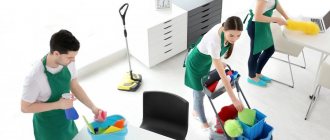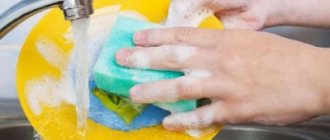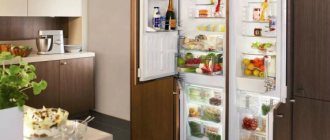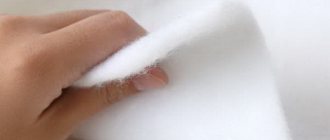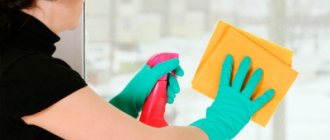What are they?
Window cleaning involves more than just cleaning the glass. The frames and window sills also need to be put in order. In addition to the usual rags and sponges, you can use special purchased rags for cleaning.
Synthetic suede
The faux suede napkin has an embossed pattern, giving the material volume and corrugation. This fabric is characterized by high density and rigidity, coping with dirt no worse than a scraper. Ultra suede is well known to car enthusiasts as it helps keep the car clean.
Material composition - multilayer material has many advantages:
- the texture is porous, thanks to which it absorbs moisture well;
- both sides of such a napkin are working, so when washing the window, you can simply turn the rag over;
- You don’t have to rinse the napkin often, since both sides are used;
- the synthetic composition does not leave lint on the glass.
The peculiarity of the application is the need for storage in a damp state in a special plastic package. If you do not follow this rule, the surface will become hard. Despite the fact that the material is wet, such a cloth allows you to wipe the surface dry and is suitable for rubbing.
Microfiber
Not every microfiber cloth is ideal for cleaning windows. Their surface should be sufficiently dense and smooth. One of the good options is offered by the domestic one.
Using such equipment is very simple:
- Moisten the napkin.
- Squeeze out excess moisture.
- Wipe the glass.
This option is suitable for regular cleaning, but may not cope with serious dirt and neglected windows. Another disadvantage is the high cost for a quality product. When using a cheap analogue, the effect is much lower.
Sponge
The option of using a sponge is quite popular . This device allows you to apply a generous amount of detergent to the window and distribute it well.
This method will help in cases where the glass is in poor condition and needs to be soaked.
Another advantage is low cost. You can use any sponge, even a cheap one. But it is better to give preference to the one that does not have a hard side that can damage the frame or seal.
There are also disadvantages. A porous spongy surface is not able to wipe the surface dry , much less add shine. For these purposes, you will need to use either another napkin of a different type, or a squeegee.
Cotton
Cotton napkins are a fairly expensive option for rags for cleaning windows. They differ in size, absorb liquid well, and can be used several times.
But they are not very suitable for washing glass , as they quickly become wet and cannot help with adding shine. Most often, this type of rag is used for cleaning floors.
Latex
Latex wipes are another rag option that can be used for cleaning windows. This method is suitable only at the first stage - when applying the cleaning composition to the glass. Cleaning and adding shine will have to be done with other rags.
Latex can be used repeatedly. Washing napkins is allowed, but not in hot water.
For glass, such napkins are rarely used , since they cannot cope with all types of dirt, and do not even eliminate fingerprints.
Viscose, cellulose
Viscose napkins are only suitable for applying cleaning composition to glass.
They are not intended for dry use. The material does not damage the surface, but is not able to make windows shine .
Napkins made from cellulose and viscose are not very durable. They may tear when twisted. If you leave such rags wet, fungus will quickly settle on them.
Rags
Using pieces of fabric and old items is one of the common options for rags for cleaning windows. If the choice is made in favor of rags, then not every material will do.
You need to choose a lint-free fabric that absorbs moisture well and does not fade . Optimally - light cotton or linen.
Synthetics are not suitable for these purposes, as they do not have sufficient absorbency and can only smear dirt and not remove it.
Using a rag, you can easily apply a glass cleaning agent. In order to wipe the surface dry, and even more so to give the glass a shine, you will need to use several rags, constantly replacing the wet one with a dry one. Additionally, squeezing can be applied.
Where is it profitable to buy rags for any surfaces in bulk?
In our online store you can buy woven and non-woven rags for wet cleaning of the house wholesale or retail at inexpensive prices from the manufacturer. With their help, the cleaning process will turn into a pleasant, non-labor-intensive event. The cleaning cloth does not leave lint and has high absorbency. Can be used on any surface. Withstands repeated washing.
Among the assortment presented in the catalog, you can choose and buy cleaning napkins and rags in bulk from the manufacturer at a competitive price. Products: napkins, sponges, and other devices for wiping surfaces, presented both in individual packaging and in sets.
All products are of high quality and make the cleaning process easier for residential, commercial, premises, catering establishments, retail and other areas.
Select an option
Each housewife chooses the best option for herself , guided by the following factors:
- price;
- duration of service;
- ease of use;
- the duration of the window cleaning process itself.
The cheapest option is to use rags or sponges. But the window cleaning process will in this case take longer than when using a microfiber cloth or artificial suede.
Store-bought rags for cleaning windows - artificial suede and microfiber - have a fairly long service life . But only if you purchase quality products.
Latex, cellulose, cotton and rayon are impractical choices, especially when you need to clean quickly, thoroughly, and with just a rag.
Window cleaning robot as an alternative option
A window cleaning robot is a worthy alternative to manual washing, which greatly facilitates this process. In order not to waste time on cleaning and practically not take part in this process, it is recommended to use a special device - a robot for washing glass and windows.
The instructions for using this new technology will not leave any questions: you just need to place the device on the glass, and then it will do everything necessary. A popular model of such a robot is a device called a “trunk”.
How to wash without streaks, detergents?
Washing windows using rags or special products must be properly organized. First you need to prepare the area - remove foreign objects, blinds and curtains so that they do not interfere.
Window cleaning includes the following main steps:
- Elimination of dust and heavy dirt.
- Application of detergent composition.
- Surface cleaning.
- Bringing shine.
If the windows are in a state of disrepair, preliminary removal of contamination may require the use of additional devices and household chemicals. Rags cannot cope with cement or paint stains.
Application of window cleaning composition can be carried out in two main ways:
- The composition is sprayed onto the glass surface and wiped with a dry cloth.
- The rag itself is soaked in the cleaning solution and wrung out.
The choice of option depends on the type of dirt and the type of cleaning cloth. After the cleaning agent has been applied, it is necessary to wash the window, carefully working through difficult and especially dirty areas. If the windows have not been washed for a long time, re-treatment may be necessary.
If the glass is washed quite often, then it is not necessary to use household chemicals; it is enough to simply wet clean and polish the surface.
Why do streaks remain on glass?
Stains, stains and deposits remain on the glass after cleaning for many reasons. Even with perfect cleaning, unpleasant marks may remain. And the reasons for this phenomenon lie in the following factors:
- Cleaning in hot weather. Under the influence of direct sunlight, moisture quickly evaporates, which leads to the appearance of stains. It is for this reason that it is not recommended to clean windows in such weather.
- Incorrectly selected chemicals for washing. Some low-quality compounds may leave cloudy marks on the glass. In addition, abrasive particles can scratch windows and leave streaks.
- Incorrect cleaning method. Stains and stains may remain if all dust has not been removed from the windows first. Window cleaning is carried out in several stages, which are accompanied by the preparation of glass and the use of chemicals.
To wash a window without streaks and deposits, it is important to choose the right technology and cleaning products.
Recommendations
Advice from cleaning experts will help simplify the solution to the issue of cleaning and washing windows:
- Any cleaning should be done with rubber gloves.
- Rags can be used both for applying detergent composition and for adding shine.
Wiping away moisture with crumpled up newspaper is a good option when you need to restore shine after using a rag or sponge.- The water container should be comfortable - stable and not too small.
- Not only a store-bought product is suitable as a detergent, but also one made independently according to home recipes.
- Areas that are inconvenient to clean (for example, at the junction of the frame and glass) can be washed with an old toothbrush.
- Plastic frames must not be treated with caustic acids.
- Seals and metal fittings should be wiped first with a damp cloth and then with a dry one.
- Do not leave the rag dirty after cleaning.
You will find a lot of important and useful information about fast and effective window cleaning in this section.
What kind of napkins are these, what is the principle of their operation?
An innovative product - cleaning wipes without detergents - are made of non-woven material and are characterized by increased absorption of moisture, small particles of dirt and grease.
Particularly thin fibers (the base of the non-woven fabric) are cut into several parts, which provides a capillary effect. For reference: the capillary effect is a physical phenomenon in which wetting liquids rise through capillaries, and non-wetting liquids descend.
Due to the numerous flat slits in the fibers, capillary force helps to quickly attract any contaminants to the surface of the rag. Combining several types of materials (for example, polyamide and polyester) that differ in electrostatic charge in one napkin enhances the capillary effect.
In order to enhance the neutralizing effect of rags, the manufacturer adds silver ions to the non-woven material .
Pros and cons of use
Those who have just acquired a cleaning cloth for cleaning without detergents will appreciate its benefits after the first use:
- easy care (after use, just rinse the cloth under running water);
- environmental friendliness (quickly and efficiently cleans any surface without the use of household chemicals harmful to the environment);
- has bactericidal properties (in addition to particles of dust, grease and small debris, it removes bacteria and fungi, mold spores from surfaces);
- practicality (non-woven material does not leave lint after cleaning, retains the shine and gloss of polished surfaces);
- cost-effectiveness (considering that cleaning with such a cloth does not require detergents, the budget savings are obvious).
Of course, with all the positive properties of chemical-free cleaning wipes, you cannot do without some negative aspects:
- in comparison with household chemicals, it will take much longer to remove burnt-on grease and stubborn dirt with a rag for cleaning without detergents;
- Washing dishes without chemicals with a special napkin increases water consumption.
Many people think that chemical-free cleaning cloths are very expensive. But comparing how much money is spent on various household chemicals, and most importantly, the harm that these chemicals have on human health and the environment, the question of the high cost of special cleaning wipes disappears by itself.
How to extend service life?
Manufacturers of special rags for cleaning without chemicals guarantee a service life of two to five years. But with proper care, you can extend the life of the napkins.
It is enough to follow some rules:
After each use, rinse the napkin under running water without using synthetic detergents.
In special cases (if very heavily soiled), the rag can be washed in a washing machine using shavings of laundry soap instead of powder.- Drying is carried out only in a dark, well-ventilated place. Rags should not be dried on a radiator or near an open fire. Store washed and dry rags in a clean, closed closet.
On the packaging, the manufacturer must provide clear instructions for the proper use and storage of special wipes. A detailed study of the information and strict adherence to all recommendations will help preserve the beneficial properties of the rags for the longest possible period of time.
Why and how to use it?
When choosing a cleaning napkin, you need to pay attention not only to the cost and size, but also to the purpose for which it is intended.
Cellulose or bamboo rags can be used to clean greasy deposits on kitchen surfaces or lime deposits on bathroom tiles. A microfiber cloth will help you clean the floor efficiently and without streaks. It will also help remove specks and dust from polished furniture.
Microfiber cloths with very short pile (or no pile at all) will restore shine and shine to mirror and glass surfaces in a matter of minutes.
A viscose rag will help clean household appliances from dust . It will not only remove all debris, but also remove static tension, which attracts the smallest specks from the air to the surface.
Types of materials from which cleaning wipes are made
Cleaning the house is a daily and labor-intensive task. To make it easier, manufacturers have created special napkins. Today in stores you can find a large assortment of this product. The area of application differs depending on the material. Therefore, let's look at this issue in more detail.
- Cellulose . The main feature of such products is a high degree of liquid absorption. The material is natural and therefore safe. When dry, such products are hard and dry. This ability helps prevent the proliferation of bacteria and fungi. Products are used only in wet form. They collect dust well and do not leave streaks. Such a rag requires special care: do not rub too hard, do not twist or bend it when dry, wash only by rinsing in soapy water.
- Microfiber . This is a synthetic material consisting of polyester and polyamide. Due to the special structure of the fabric, such rags gently polish the surface, penetrate into shallow recesses and remove dust and dirt well. They perfectly absorb moisture and are used for dry and wet cleaning. The product can be washed by hand or in a machine at a temperature of 60 C, and dried only naturally.
- Viscose . Natural material made from compressed wood pulp. Suitable for dry cleaning of household appliances, as it does not create static. The downside is that such napkins quickly disintegrate and begin to emit unpleasant odors. Therefore, they need to be changed frequently.
- Bamboo . This is a natural material that easily absorbs dirt and gets rid of it when washed. The products have a good moisture absorption rate. Does not retain unpleasant odors. They can be used for any type of cleaning. Suitable for washing dishes without using detergents. They can withstand up to 500 washes, which means they can last for a very long time. The fabric is not subject to rotting.
Features of use
For dry cleaning, there is no need to wet the cloth. Thanks to the properties of the fiber from which the cloth is made, one hand movement is enough to collect:
- all dust particles
- garbage,
- as well as fungi,
- dust mites from a contaminated surface.
Before starting wet cleaning, lightly moisten the cloth with water (you can use a spray bottle). To clean particularly contaminated surfaces, dip a rag in water for a few minutes, then squeeze thoroughly to remove excess moisture.
The process of washing dishes deserves special attention . A detergent-free napkin does a great job of removing grease if you wash dishes under running hot water. Particularly contaminated kitchen utensils (a cup with coffee residue, a pan with dried fat) are treated with a damp, wrung-out cloth several times.
After cleaning, the cloth must be washed in hot water. If there are particles of fat or other stubborn dirt left on the fabric, immerse the rag in boiling water for 2-3 minutes (no longer).
Top 3 best brands
Among the range of cleaning wipes without chemicals, the most attractive in terms of quality and efficiency are:
Greenway AQUAmagic
High-tech napkins and towels made from split fiber. They will quickly remove any dirt and unpleasant odors from the surface . Products are manufactured in Japan. The price of one cleaning napkin is 500 rubles. Read reviews here and here.
Homestar
Cloths made of a variety of materials (microfiber, bamboo, viscose) will quickly cope with any stains without aggressive household chemicals. Among the entire variety of Homestar napkins, everyone can choose the most suitable option for themselves. Price of the set (3 pcs.) 100 rub.
Bon Home
Multifunctional bamboo fiber cloths perfectly clean any surface without detergents. The average cost of a package (5 pieces) is 50 rubles. Read reviews here.
Before purchasing, it would be a good idea to ask the seller to show quality certificates for the selected napkins. This is the only way to be sure of the effectiveness and beneficial properties of the selected product.
Reviews
Housewives who have already tried cleaning wipes without detergents in practice share positive reviews and impressions:
Alena, Kazakhstan, Astana : “It’s been ten months since I replaced household chemicals with one super-rag for cleaning without detergents, and I don’t regret it. The house is clean and tidy, while my hands remain soft and gentle. A napkin for cleaning without chemicals is of course more expensive than ordinary rags, but such costs are not comparable to health and clean air in the house.”
Maria, Moscow : “At first I was skeptical about using these miracle wipes. But under the pressure of a friend, I made up my mind and bought myself several napkins for cleaning without detergents. A miracle happened. The napkin perfectly cleans kitchen surfaces, dishes, tiles, bathroom tiles and hallway floors.”
Olga, Novorossiysk : “For more than five years, there have been no household chemicals in my house. In the first few years, gels and powders were replaced by lemon juice and baking soda, but I was able to give them up when I cleaned the house for the first time using a special napkin. Quickly, efficiently and, most importantly, safely, the rag removes any dirt, grease stains, or mold.”
